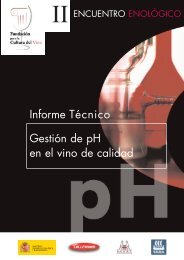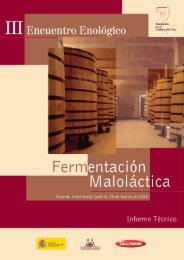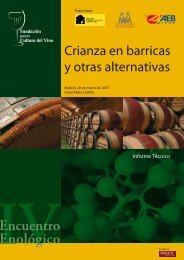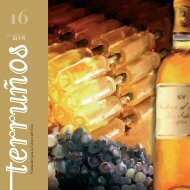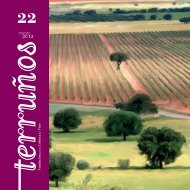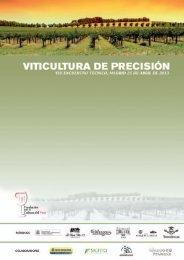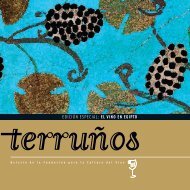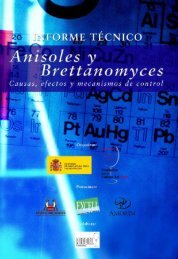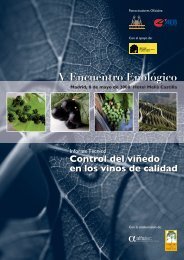Compuestos azufrados volátiles en vinos - Fundación para la ...
Compuestos azufrados volátiles en vinos - Fundación para la ...
Compuestos azufrados volátiles en vinos - Fundación para la ...
You also want an ePaper? Increase the reach of your titles
YUMPU automatically turns print PDFs into web optimized ePapers that Google loves.
Effect of Micro-oxyg<strong>en</strong>ation on Color and Anthocyanin-Re<strong>la</strong>ted Compounds of Wines with Differ<strong>en</strong>t Ph<strong>en</strong>olic Cont<strong>en</strong>tsFigure 3. Developm<strong>en</strong>t of direct anthocyanin-f<strong>la</strong>vanol adducts and polymeric compounds in W1, W2, andW3 wines (±SD). Each point corresponds to t 0, t 1, t 2, and t 3.hydroxyl group attached to C5 in the anthocyaninmolecule. Some compounds result from the additionof anthocyanin and pyruvic acid (carboxypyranoanthocyanins).Several of these compounds weredetected in our samples: petunidin 3-glucoside pyruvate,vitisin A (malvidin 3-(glucoside)pyruvate), acetylvitisin A (malvidin 3-(acetylglucoside) pyruvate), andcoumaryl vitisin A (malvidin 3-(coumarylglucoside)pyruvate). Another pyranoanthocyanin resulting fromthe cycloaddition of acetaldehyde to malvidin 3-glucoside,and referred to as vitisin B, also was found, andits quantification was included with the carboxypyranoanthocyanins.Pyranoanthocyanins are consideredto be important compounds concerning the color ofred wine since the cycloaddition process seems tostrongly increase the stability of the products, and, inthis way, vitisin A has be<strong>en</strong> reported as being morestable than malvidin 3-glucoside or ethyl-linked compoundsand more resistant to oxidation (41). The sumof carboxypyranoanthocyanins and vitisin B increasedfrom t0 to t1 (Figure 2), with MO wines increasingmore (except for W1). At the <strong>en</strong>d of the experim<strong>en</strong>t,carboxypyranoanthocyanins showed lower conc<strong>en</strong>trationsin the control wines than in the MO wines,the greatest increases being detected in W2. Otherauthors found a strong decrease in vitisin A and re-<strong>la</strong>ted compounds during the first year of wine storage,after which the conc<strong>en</strong>tration remained re<strong>la</strong>tivelyconstant (42–44). Such a decrease, observed mainly inour study betwe<strong>en</strong> t1 and t2, was ascribed to their incorporationinto polymeric compounds (42). The conc<strong>en</strong>trationof carboxypyranoanthocyanins in wines isa result of a ba<strong>la</strong>nce betwe<strong>en</strong> the formation reactionsand their incorporation in the polymeric compounds.The formation of vitisin A and re<strong>la</strong>ted compoundsrequires the pres<strong>en</strong>ce of free monoglucosides andpyruvic acid. Oxyg<strong>en</strong> or reactive oxyg<strong>en</strong> species arealso necessary for the reaction to proceed since allcycloaddition pathways require an oxidation step torecover the f<strong>la</strong>vylium moiety within the final structures(45–47). Therefore, the MO process seemed to<strong>en</strong>hance the formation of vitisin-type compounds byproviding oxyg<strong>en</strong>. This result is contrary to that of Atasanovaet al. (8), who stated that the addition of pyruvicacid to anthocyanins is not influ<strong>en</strong>ced by oxyg<strong>en</strong>.W2, with a higher anthocyanin monoglucoside cont<strong>en</strong>t(as quantified by HPLC), was the wine showingthe highest final conc<strong>en</strong>tration of carboxypyranoanthocyanins.Another group of anthocyanins, constituted byhydroxyph<strong>en</strong>yl- pyranoanthocyanins, results from96



